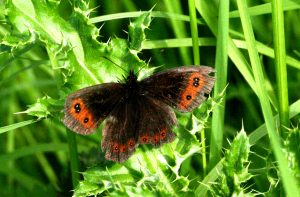 Roadside verges are not the places we readily think of a far as butterflies are concerned. However, in the next few weeks there are a number of butterflies that can be found there, especially if the verges border woodland or grassland. One of these is the Scotch argus and one of the delights of the summer sunshine is to see these large butterflies flitting along the verges as they are such a rich brown colour and stand out. The photograph of the Scotch argus was taken on a roadside verge near Inverness. The food plants of the caterpillars are grasses so the adult butterflies have no need to look for special foodplants. Indeed the Scotch argus has the remarkable habit of actually laying eggs as it flies over a verge as it knows there will be grasses underneath. The butterfly has a unusual distribution as apart from a few colonies in the Lake District in England it is confined to Scotland where it can occur in very large colonies indeed.
Roadside verges are not the places we readily think of a far as butterflies are concerned. However, in the next few weeks there are a number of butterflies that can be found there, especially if the verges border woodland or grassland. One of these is the Scotch argus and one of the delights of the summer sunshine is to see these large butterflies flitting along the verges as they are such a rich brown colour and stand out. The photograph of the Scotch argus was taken on a roadside verge near Inverness. The food plants of the caterpillars are grasses so the adult butterflies have no need to look for special foodplants. Indeed the Scotch argus has the remarkable habit of actually laying eggs as it flies over a verge as it knows there will be grasses underneath. The butterfly has a unusual distribution as apart from a few colonies in the Lake District in England it is confined to Scotland where it can occur in very large colonies indeed.
In contrast to some butterflies the Scotch argus is unusual in that it is confined to well defined colonies from which they seldom stray. The rich dusky wings are adorned with a series of intense white spots hence the name of “Argus” after the giant of Greek mythology that possessed a hundred eyes. In places in the Highlands it can be the commonest butterfly but it has a strange distribution. It does not occur north of Laxford bridge on the west coast and not north of the Dornoch Firth on the east coast. According to the “Atlas of Highland Butterflies” they fly from the first week in July to the end of September depending on the weather. It hibernates for the winter as a caterpillar.
In contrast one of the success stories of butterfly conservation in recent years has been the spread of the speckled wood. Perhaps one of the reasons for this is that at one time it was only found, as the name suggests, in woodland whereas these days it can be seen flying along roadside verges even sometimes with the Scotch argus. Speckled woods must have the longest flight period of any of the butterflies as the adults can be seen on the wing any time from late February until early November. However, that bland statement is from the colonies down south as further north in the Highlands a more likely season is early May to late September. The chocolate brown and cream uppersides of the wings are unmistakable and the males are particularly conspicuous as they sit in woodland glades and defend territories against other males and attract females.
The remarkable spread of the speckled wood is dramatically shown on maps in the Highland Butterfly Atlas. Three maps cover 1980-1988, 1980-1992 and 1980 – 1996. The most dramatic spread is around Inverness with an apparent spread along the west coast right up in the last map to north west Sutherland. This does not include a very isolated and odd record I made with late Bill Henderson so many years ago for a speckled wood in scattered woodland well north of Ullapool. Could this be simply a lack of coverage of observers in those early days? Speckled woods in Britain are remarkable and unique in that they can over winter as caterpillars or chrysalises. One can only hope that this year will produce more butterflies than in previous years, although the cold spring this year, and for that matter a cold start to June, has not helped.
Tags: highland wildlife
